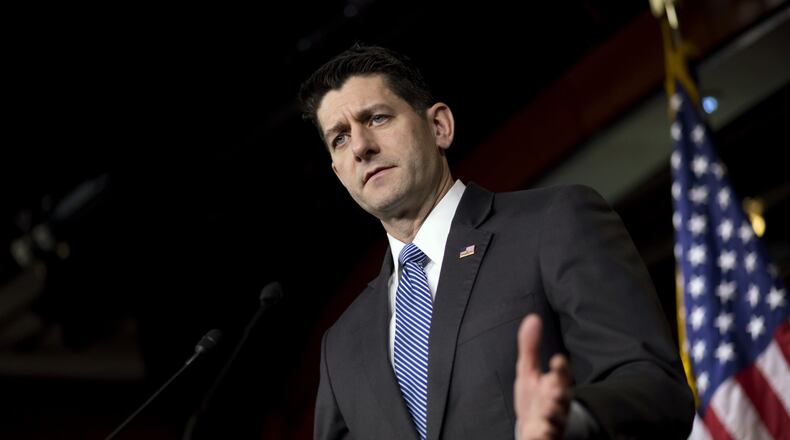Rep. Mike Turner, R-Dayton, is opposed by political newcomer and Democrat Theresa Gasper in the 10th congressional district, which includes all of Montgomery and Greene counties and part of Fayette County.
Although most observers still see Gasper as a long shot to replace Turner, who has held the seat since 2003, Gasper did raise more money than her Republican opponent in the first quarter.
The 1st and 12th congressional seats were also blowouts in the 2016 election, but 2018 presents a very different challenge. President Donald Trump’s approval ratings are below 50 percent, Pat Tiberi’s retirement in the Columbus area’s 12th district means there is an open seat being contested there, and Rep. Steve Chabot, R-Cincinnati, lost his 1st district seat once before, falling to Steve Driehaus in 2008 before defeating the Democrat two years later. The district was redrawn after the 2010 Census.
While Republicans are favored to retain both seats — Chabot won his re-election in 2016 by nearly 20 percentage points — Ryan’s presence in the state says something about Republicans’ concern over whether the GOP will be able to hang onto the speaker’s chair next year.
Democrats need to pick up just 23 seats to retake the House — 40 fewer than the 63 that changed hands in 2010, the last mid-term election during a president’s first term.
“If the Democrats netted a seat in Ohio, it probably is suggestive they are winning the House,” said Kyle Kondik, managing editor of a major political web site at the University of Virginia’s Center for Politics. “The Democrats can win the House without winning any seats in Ohio.”
Wishful thinking?
To Republicans, Democrats are engaging in an exercise of wishful thinking. They point out that the non-partisan Congressional Budget office projects the economy will expand at a brisk 3 percent pace this year while Ohio’s unemployment rate has tumbled to 4.3 percent.
Republicans also note that Trump, while unpopular in blue states and even some purple ones, has an approval rating in Ohio that has been steady at 46 percent. And no one can deny that the state’s congressional maps — drawn by Republicans — favor incumbents. That’s largely why Democrats aren’t holding out much hope that Democrat Susan Moran Palmer will beat Republican Anthony Gonzalez in the 16th district in northeast Ohio, even though that too is an open seat.
Rep. Jim Renacci of Wadsworth, who is running for the U.S. Senate against Democratic Sen. Sherrod Brown, received more than 65 percent of the vote in winning re-election to the seat in 2016.
“We’re talking about seats which are reliably Republican and Ohio is seemingly handling Trump’s America with fewer speed bumps than most other states,” said Jeff Sadosky, a Republican consultant in Washington. “Trump polls better in Ohio than he is in in other states like Virginia and Colorado.”
Corry Bliss, who is directing a political action committee aimed at helping Republican House candidates, quipped, “There’s a better chance of (former Gov. Ted Strickland) coming out of retirement and winning a statewide race than us losing any of those seats. I hope the Democrats spend all their money in Ohio.”
‘The anxiety is still there’
Nationally, however, there are signs Republicans fear a blue wave this fall. No fewer than 48 House Republicans, including the House speaker, are not seeking re-election.
And there’s a wildcard: Special Counsel Robert Mueller’s investigation into whether Trump campaign in 2016 colluded with Russian officials to damage Democratic presidential nominee Hillary Clinton’s campaign. Nobody can predict with any certainty whether Mueller will bring charges against additional Trump advisers.
“The map Republicans drew can hold up in good years for their party but it may be under stress when there is an unpopular president,” said David Wasserman, a congressional analyst for the non-partisan Cook Political Report in Washington.
In the end, Republicans think they can hold onto their Ohio seats by reminding voters of the tax cut they passed last year.
“If Republicans can effectively make a case on it and not have their message diluted by the tweet of the day, there is real upside,” Sadosky said.
Ohio, too, may be a safe harbor for Republicans.
“People’s view of the direction of the state and the country is better here than other places across the country,” said Terry Casey, a Republican consultant in Columbus.
Youngstown-area Rep. Tim Ryan, D-Niles, doesn’t buy it.
“We’re moving into a newer era of what a good economy means. The question is a good economy for whom?” he said. “It’s not just about employment. It’s about wages, pensions and security. I see it every day. The anxiety is still there.”
Jessica Wehrman of the Washington bureau contributed to this story.
Ohio House races
Every seat in the U.S. House of Representatives is up for election this year. Most Ohio districts are considered safe, but analysts believe at least two races will be competitive.
Leans Republican: Chabot (1st district), Open (12th)
Likely Republican: Gibbs (7th), Joyce (14th), Stivers (15th), Turner (10th)
Safe Republican: Wenstrup (2nd), Latta (5th), Johnson (6th), Jordan (4th), Davidson (8th), Open (16th).
Safe Democrat: Beatty (3rd), Kaptur (9th), Fudge (11th), Ryan (13th)
Republican tossup: Open (12th)
Lean Republican: Chabot (1st)
Likely Republican: Turner (10th), Joyce (14th), Stivers (15th)
Solid Republican: Wenstrup (2nd), Jordan (4th), Latta (5th), Johnson (6th), Gibbs (7th), Davidson (8th), Open (16th)
About the Author




